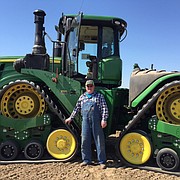Columbia Basin Development League leader's farm started one year before the Grand Coulee discussion
Ted Escobar | Hagadone News Network | UPDATED 8 years, 10 months AGO
OTHELLO — According to historical sources, official discussion of the Columbia Basin Irrigation Project started in 1902, the same year the Bureau of Reclamation was formed.
But you have to wonder if Texan F. M. Lyle knew something others didn’t, or at least had a hunch about the future irrigation project.
Lyle left Texas in 1901 to dry-farm wheat in an area east of Othello identified today as the junction of Highway 26 and Johnson Road. When the U.S. government formed the Bureau of Reclamation the next year, the biggest idea ever for irrigation came into view.
The plan called for the irrigation of about 1,100,000 acres of land, according to Reclamation’s website. It included all of Lyle’s land, but Columbia River water has still not arrived 116 years later.
The farm has worked its way down the family to Kevin Lyle, and he holds out hope the CBP will eventually send water his way. He was just named chairman of the board of the Columbia Basin Development League, an advocacy organization formed in the 1960s.
Lyle farms about 4,500 acres today, with about 2,000 under irrigation. But the water comes from wells drilled by his father Rex and his uncle Elwyn.
“They could see the neighbors were enjoying the advantages of irrigation (from the river),” Kevin Lyle said.
Although it became more costly than originally anticipated, the government started building Grand Coulee Dam, Banks Lake and the project in 1933. The dam was finished in 1942, but the irrigation part of the plan was held up because of World War II.
All of the power produced at the dam was dedicated to other needs, such as plants that were producing war materiel. However, Columbia River irrigation water was brought to about 5,000 acres of the Basin by a pumping operation near Pasco in 1948.
Despite reservations raised by costs, the CBP was resumed by the Bureau after the war. The first irrigation water from Banks Lake arrived in 1952, and the CBP started to develop and expand.
Starting in the 1960s, however, rising costs and other concerns took center stage, and the project came to a halt at about 671,000 acres. The CBDL, including the Lyles, has been advocating for completion ever since.
“We were trying to get back to development in the 1990s, but they put a moratorium on the river because of fish,” Lyle said.
The canals that were planned to reach beyond what is now Highway 395 became part of a ghost history. They had names like Black Rock and Michigan Prairie.
The original main canal that was supposed to feed the land east of Othello and Warden was named the East High and was to start north of Odessa. It is only a discussion now.
Another discussion is the Odessa aquifer, from which Lyle and other Othello area irrigators draw their water. It is being depleted.
“They tell me I’m irrigating with ancient water – 10,000 years old,” Lyle said. “That means the aquifer is not being replenished.”
That is one of the reasons Lyle would like to see Columbia River water. The 2,000-acre state (well) water right could be replaced by a 2,000-acre federal water right.
According to Lyle, 87,000 acres of land in his part of the Basin could be developed with service from the East Low Canal, which serves some of the Othello area. It would take five miles of pipe to get water to his farm and a total of 10,000 acres in his area.
Lyle and other members of the CBDL will be in Olympia on Feb. 13-14 to, once again, try to get the legislature behind their hopes and dreams.
According to Lyle, the irrigation question in his part of the Basin is not a one-sided discussion. There are dryland farmers who don’t want to pay the cost of bringing Columbia River water. Most are not members of the CBDL.
“Some of them are,” Lyle said. “They joined because we’re trying to get the costs down.”
The dryland farmers who do want Columbia River water want it for the same reason Rex and Elwyn Lyle drilled wells – economics. Lyle noted the value of dry land is from $400-$800 and acre. Irrigated land is valued at $6,000-$10,000 an acre, he said.
According to Lyle, dryland farmers can expect from 10-70 bushels of wheat (mostly the winter variety). Some years there is not enough rain to grow a good crop. Some years there is not enough rain to germinate the seed. Some years, when there is no snow cover, winter kill is a challenge.
An irrigated farm can produce 100-150 bushels of wheat per acre, can count on water and germination, Lyle said. At last Saturday’s price of wheat at Lind, $3.93 per bushel, dryland farmers could see a high return of about $275 per acre and irrigation farmers could see a high return of about $590.
Another advantage of an irrigated wheat farm is that a fallow year is not required. Farmers can raise a crop on the same ground every year.
Lyle noted that his farm could add new crops to his operation, such as potatoes, with Columbia River water. The mainstay crops now are Kentucky bluegrass seed, wheat, canola and corn. Those are crops with lower water requirements.
Most of the wheat acreage is 2,000 dry acres. They could be made more productive with Columbia River water. And the crop could be changed to a summer variety.
Completion of the CBP may not come in Kevin Lyle’s lifetime, but, through the CBDL, he will continue to try to make it happen.





